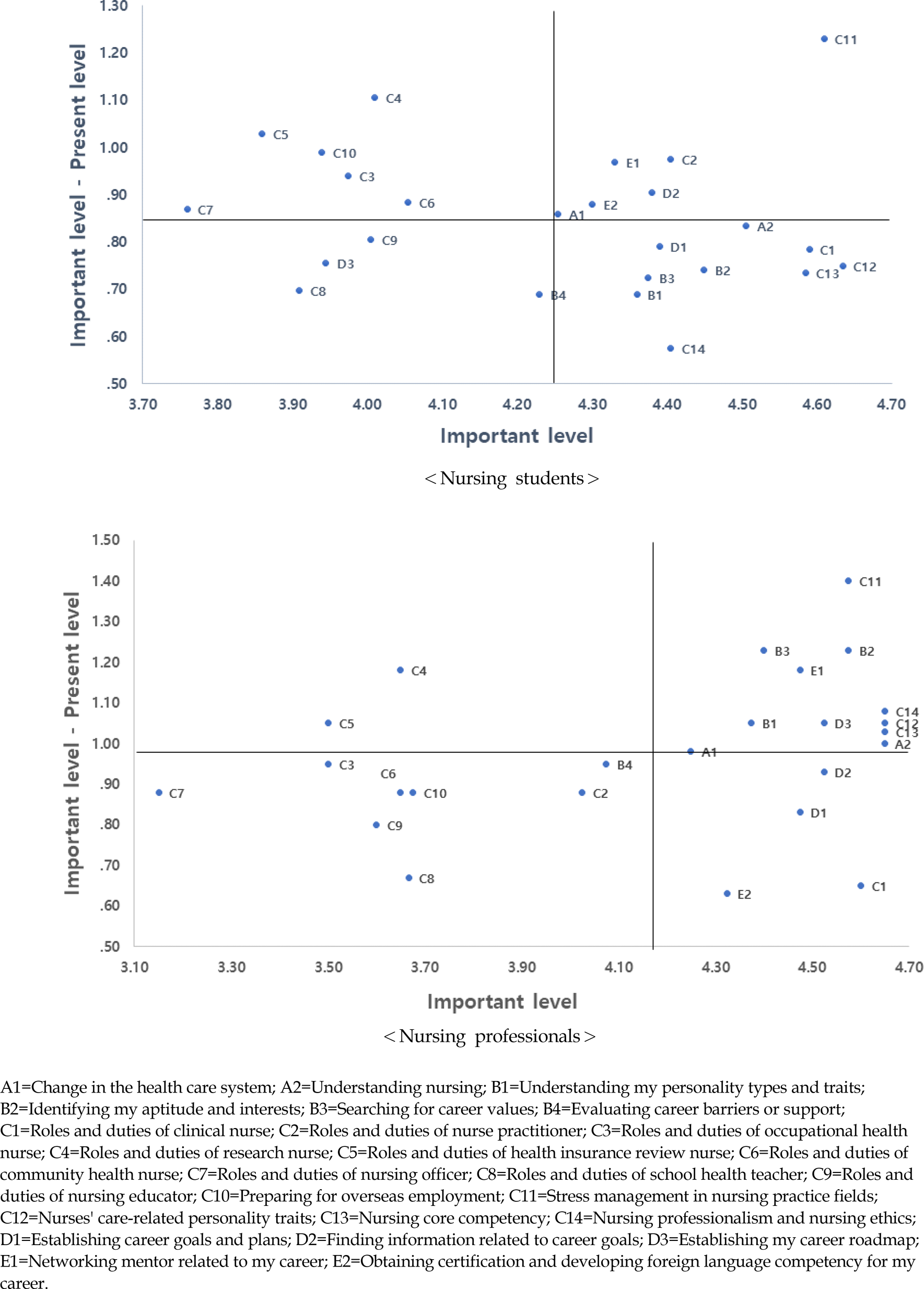Abstract
Purpose
This study aimed to assess the educational needs that should be considered while developing an occupational education program for nursing students.
Methods
Participants included 200 nursing students and 40 nursing professionals. The data were analyzed with SPSS/WIN 24.0 and AMOS 24.0 program, using descriptive statistics, a paired t-test, Kendall's coefficient of concordance, and confirmatory factor analysis. The Borich's Needs Assessment Model, the Locus for Focus Model, and the Jo and Lee's Model also were used. Data were collected from May 1 to 30, 2017 using a structured self-report questionnaire.
Results
A significant difference was found in scores on ‘ important’ and ‘ present’ levels of occupational education needs for both nursing students and professionals, on all items of occupational education needs. Results relative to the Borich's model indicated that ‘ stress management in the nursing practice fields’ had the highest priority rating among both nursing students (5.65) and nursing professionals (6.40), and ‘ establishing my career roadmap’ (6.04) had the highest priority rating in the Jo and Lee's Model.
REFERENCES
1. Daily UNN. Career education in university [Internet]. Seoul: University News Network;2016. [cited 2016 December 1]. Available from:. http://news.unn.net/news/articleView.html?idxno=166817.
2. RNjob. RNjob Education Information [Internet]. Seoul: Korean Nurses Association;2017. [cited 2017 July 1]. Available from:. http://www.rnjob.or.kr/edu/list.php.
3. Jung JS, Jeong MJ, Yoo IY. Relations between satisfaction in major, career decision-making self-efficacy and career identity of nursing students. The Journal of Korean Academic Society of Nursing Education. 2014; 20(1):27–36. https://doi.org/10.5977/jkasne.2014.20.1.27.

4. Teoh YTE, Pua LH, Chan MF. Lost in transition-a review of qualitative literature of newly qualified registered nurses' experiences in their transition to practice journey. Nurse Education Today. 2013; 33(2):143–7. https://doi.org/10.1016/j.nedt.2012.08.016.
5. Park SJ. The effects of career education on career development for nursing students. The Journal of Korean Academic Society of Nursing Education. 2012; 18(2):259–67. https://doi.org/10.5977/jkasne.2012.18.2.259.

6. Ko YJ, Kim IK. The relationship between professional nursing values and career preparation behaviors of nursing students. The Journal of Korean Academic Society of Nursing Education. 2011; 17(1):62–71. https://doi.org/10.5977/JKASNE.2011.17.1.062.

7. Kwon KN, Choi EH. Factors affecting career identity of nursing students. The Journal of Korea Community Health Nursing Academic Society. 2010; 24(1):19–28.
8. Bang KS, Cho JK. Recognition of nursing students and graduates on nursing and future career. The Journal of Korean Academic Society of Nursing Education. 2008; 14(1):88–97. https://doi.org/10.5977/JKASNE.2008.14.1.088.

9. Waddell J, Spalding K, Canizares G, Navarro J, Connell M, Jancar S, et al. Integrating a career planning and development program into the baccalaureate nursing curriculum: part I. impact on students' career resilience. International Journal of Nursing Education Scholarship. 2015; 12(1):162–73. https://doi.org/10.1515/ijnes-2014-0035.

10. Waddell J, Spalding K, Navarro J, Jancar S, Canizares G. Integrating a career planning and development program into the baccalaureate nursing curriculum: part II. outcomes for new graduate nurses 12 months post-graduation. International Journal of Nursing Education Scholarship. 2015; 12(1):175–82. https://doi.org/10.1515/ijnes-2015-0028.

11. Park SY. An analysis of evaluation needs of the adult literacy educational program. Journal of Lifelong Education. 2009; 15(3):1–20.
12. Hwang YH, Park SJ. Educational needs analysis for key vocational competency in nursing students. Journal of the Korea Academia-Industrial Cooperation Society. 2016; 17(11):595–603. https://doi.org/10.5762/KAIS.2016.17.11.595.

13. Cho DY. Exploring how to set priority in need analysis with survey. Journal of Research in Education. 2009; 35:165–87.
14. Jo MH, Lee HW. A study on a modification of educational needs assessment model according to the difference of perceived importance between pre-service and in-service teachers. Korean Journal of Teacher Education. 2016; 32(3):147–68. https://doi.org/10.14333/KJTE.2016.32.3.147.

15. Kang HC, Yeon KP, Han ST. A review on the use of effect size in nursing research. Journal of Korean Academy of Nursing. 2015; 45(5):641–9. https://doi.org/10.4040/jkan.2015.45.5.641.

16. Kline RB. Principles and practice of structural equation modeling. 4th ed.New York: The Guilford Press;2015. p. 14–16.
17. Donner GJ, Wheeler MM. Career planning and development for nurses: the time has come. International Nursing Review. 2001; 48(2):79–85. https://doi.org/10.1046/j.1466-7657.2001.00028.x.

18. Mink OG. Developing and managing open organizations: a model and method for maximizing organizational potential. 2nd ed.Austin: Somerset Consulting Group;1991. p. 13–20.
19. Borich GD. A needs assessment model for conducting follow- up studies. Journal of Teacher Education. 1980; 31(3):39–42.
20. Jimenez C, Navia-Osorio PM, Diaz CV. Stress and health in novice and experienced nursing students. Journal of Advanced Nursing. 2010; 66(2):442–55. https://doi.org/10.1111/j.1365-2648.2009.05183.x.

21. Kim CH, Yang SS, Kim YJ, Son YJ, You MA, Song JE. A structural equation model of nurses' turnover intention. Journal of Korean Academy of Nursing Administration. 2009; 15(4):550–62.
22. Carr J. Mentoring student nurses in the practice. Practice Nursing. 2008; 19(9):465–7. https://doi.org/10.12968/pnur.2008.19.9.31152.

23. Waddell J, Bauer M. Career planning and development for students: building a career in a professional practice discipline. Canadian Journal of Career Development. 2005; 4(2):4–13.
24. McKenna L, McCall L, Wray N. Clinical placements and nursing students' career planning: a qualitative exploration. International Journal of Nursing Practice. 2010; 16(2):176–82. https://doi.org/10.1111/j.1440-172X.2010.01827.x.

25. Bowles C, Candela L. First job experiences of recent RN graduates: improving the work environment. Journal of Nursing Administration. 2005; 35(3):130–7.
26. Hallin K, Danielson E. Registered nurses' perceptions of their work and professional development. Journal of Advanced Nursing. 2008; 61(1):62–70. https://doi.org/10.1111/j.1365-2648.2007.04466.x.

27. Lee HK, Shin JS. Relationships among ethical dilemma experienced by nurses, burnout and coping. Korean Journal of Medical Ethics. 2012; 15(3):339–54.
28. Berkow S, Virkstis K, Stewart J, Conway L. Assessing new graduate nurse performance. Nurse educator. 2009; 34(1):17–22. https://doi.org/10.1097/01.nne.0000343405.90362.15.

29. Kim JA, Chu MS, Kwon KJ, Seo HK, Lee SN. Core competen-cies for new nurses. Journal of Korean Clinical Nursing Research. 2017; 23(1):40–53. https://doi.org/10.22650/JKCNR.2017.23.1.40.
30. Park JH, Hwang HY. Competency assessment of new graduate nurse: development and validation of an instrument. Information. 2014; 17(7):3455–65.
Figure 1.
Occupational education needs for nursing students and nursing professionals using the Locus for Focus Model.

Table 1.
Occupational Education Needs between Nursing Students and Nursing Professionals using a Paired t-test
Table 2.
Occupational Education Needs between Nursing Students and Nursing Professionals using the Borich's Need Model and the Jo & Lee's Model




 PDF
PDF ePub
ePub Citation
Citation Print
Print


 XML Download
XML Download